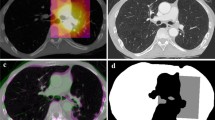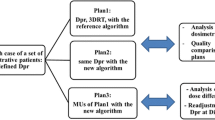Abstract
A Clinician’s discrimination between radiation therapy treatment plans is traditionally a subjective process, based on experience and existing protocols. A more objective and quantitative approach to distinguish between treatment plans is to use radiobiological or dosimetric objective functions, based on radiobiological or dosimetric models. The efficacy of models is not well understood, nor is the correlation of the rank of plans resulting from the use of models compared to the traditional subjective approach. One such radiobiological model is the Normal Tissue Complication Probability (NTCP). Dosimetric models or indicators are more accepted in clinical practice. In this study, three radiobiological models, Lyman NTCP, critical volume NTCP and relative seriality NTCP, and three dosimetric models, Mean Lung Dose (MLD) and the Lung volumes irradiated at 10Gy (V10) and 20Gy (V20), were used to rank a series of treatment plans using, harm to normal (Lung) tissue as the objective criterion. None of the models considered in this study showed consistent correlation with the Radiation Oncologists plan ranking. If radiobiological or dosimetric models are to be used in objective functions for lung treatments, based on this study it is recommended that the Lyman NTCP model be used because it will provide most consistency with traditional clinician ranking.
Similar content being viewed by others
References
Abratt, R. P. and Morgan, G. W.,Lung toxicity following chest irradiation in patients with Lung cancer. Lung Cancer, Vol. 35(2): 103–109, 2002.
Alexander, M. A. R., Brooks, W. A. and Blake, S. W.,Normal tissue complication probability modelling of tissue fibrosis following breast radiotherapy. Physics in Medicine and Biology, Vol. 52(7): 1831–1843, 2007.
Amols, H. I. and Zaider, M.,Physician/Patient-driven risk assignment in Radiation Oncology: Reality or fancy? International Journal of Radiation Oncology, Biology, Physics, Vol. 38(3), 1997.
Brahme, A.,Development of radiation therapy optimisation. Acta Oncologica, Vol. 39(5): 579–595, 2000.
Dale, E., Olsen, D. R. and Fossa, S. D.,Normal tissue complication probabilities correlated with late effects in the rectum after prostate conformal radiotherapy. International Journal of Radiation Oncology, Biology, Physics, Vol. 43(2): 385–91, 1999.
Emami, B., Lyman, J., Brown, A., Coia, L., Goitein, M. and Munzenrider, J.E.,Tolerance of normal tissue to therapeutic irradiation. International Journal of Radiation Oncology, Biology, Physics., Vol. 21(1): 109–122, 1991.
Fuss, M., Poljanc, K., Miller, D. W., Archambeau, J. O., Slater, J. M., Slater, J. D. and Hug, E. B.,Normal tissue complication probability (NTCP) calculations as a means to compare proton and photon plans and evaluation of clinical appropriateness of calculated values. International Journal of Cancer, Vol. 90(6): 351–8, 2000.
Gagliardi, G., Bjohle, J., Lax, I., Ottolenghi, A., Eriksson, F., Liedburg, A., Lind, P. and Rutqvist, L. E.,Radiation pneumonitis after breast cancer irradiation: analysis of the complication probability using the relative seriality model. International Journal of Radiation Oncology, Biology, Physics, Vol. 46(2): 373–81, 2000.
Graham, M. V., Purdy, J. A., Emami, B., Harms, W., Bosch, W., Lockett, M. A. and Perez, C. A.,Clinical dose-volume histogram analysis for pneumonitis after 3D treatment for non-small cell Lung cancer (NSCLC). International Journal of Radiation Oncology, Biology, Physics, Vol. 45(2): 323–9, 1999.
Intensity Modulated Radiation Therapy Collaborative Working Group. Intensity-modulated radiotherapy: current status and issues of interest. International Journal of Radiation Oncology, Biology, Physics, Vol. 51(4), 2001.
Jackson, G., Kutcher, J., and Yorke, E. D.,Probability of radiationinducedcomplications for normal tissues with parallel architecture subjectto non-uniform irradiation. Medical Physics, Vol 20: 613–625, 1993.
Kallman, P., Agren, A. and Brahme, A.,Tumour and normal tissue responses to fractionated non-uniform dose delivery. International Journal of Radiation Biology, Vol 62: 249–262, 1992.
Kim, T. H., Cho, K. H., Pyo, H. R., Lee, D. H., Lee, J. M., Kim, H. Y., Hwangho, B., Park, S. Y., Kim, J. Y., Shin, K. H. and Kim, D. Y.,Dose-volumetric Parameters for Predicting Severe Radiation Pneumonitis after Three-dimensional Conformal Radiation Therapy for Lung Cancer. Radiology, Vol. 235(1): 208–215, 2005.
Kwa, S. L., Lebesque, J. V., Theuws, C. M., Marks, L. B., Munley, M. T., Bentel, G., Oetzel, D., Spahn, U., Graham, M. V., Drzymala, R. E., Purdy, J. A., Lichter, A. S., Martel, M. K. and Ten Haken, K.,Radiation pneumonitis as a function of mean Lung dose: an analysis of pooled data of 540 patients. International Journal of Radiation Oncology, Biology, Physics, Vol. 42(1): 1–9, 1998.
Kwa, S. L., Theuws, J. C., Wagenaar, A., Damen, E. M. F., Boersmaa, L. J., Baasb, P., Mullera, S. H. and Lebesque, J. V.,Evaluation of two dose-volume histogram reduction models for the prediction of radiation pneumonitis. Radiotherapy & Oncology, Vol. 48(1): 61–9, 1998.
Lyman, J. T.,Complication probability as assessed from dose-volume Histograms. Radiation Res. Suppliment. Vol. 8: S13–9, 1985.
Lebesque, J. V., Seppenwoolde, Y., Belderbos, J. S., de Jaeger, K., Henning, G. T., Hayman, J. A., Martel, M. K. and Ten Haken, R. K.,Radiation pneumonitis and NTCP models. International Journal of Radiation Oncology, Biology and Physics, Vol. 51(3): Supplement 1, 86–87, 2001.
Mattia, M., Del Giudice, P. and Caccia, B.,IMRT optimization: Variability of solutions and its radiobiological impact Medical Physics, Vol. 31 (5), 2004.
Metcalfe, P., Kron, T. and Hoban, P.,The physics of radiotherapy X-rays from linear accelerators. Madison, Wis., Medical Physics Publishing, 1997.
Moiseenko, V., Battista, J., Van Dyk, J.,Normal tissue complication probabilities: dependence on choice of biological model and dose-volume histogram reduction scheme. International Journal of Radiation Oncology, Biology, Physics, Vol. 46(4): 983–93, 2000.
Niemierko, A. and Goitein, M.,Modeling of normal tissue response to radiation: The critical volume model. International Journal of Radiation Oncology, Biology, Physics, Vol 25: 135–145, 1993. or]22. Schhlegel, W., Bortfield, T., and Grosu, L.New Technologies in Radiation Oncology Published by Springer. ISBN 3-540-00321-5, 2006.
Seppenwoolde, Y., Lebesque, J. V., Jaeger, K., Belderbos, J. A., Boermsa, L. J., Schilstra, C., Henning, G. T., Hayman, J. A., Martel, M. K., and Ten Haken, R. K.,Comparing different NTCP models that predict the incidence of radiation pneumonitis. Normal tissue complication probability. International Journal of Radiation Oncology, Biology, Physics, Vol. 55(3): 724–35, 2003.
Severin, D., Connors, S. and Thompson, H.,Breast Radiotherapy with inclusion of internal mammary nodes: a comparison of techniques with three-dimensional planning. International Journal of Radiation Oncology, Biology, Physics., Vol. 55(3): 633–644, 2003.
Smith, R. P., Dwight, E. H., Huq, M. S. and Yue, N. J.,Modern Radiation Treatment Planning and Delivery-From Röntgen to Real Time. Haematology/Oncology Clinics, 2006.
Spearman, C., The proof and measurement of association between two things. The American Journal of Psychology, Vol. 15(1), 1904.
School of Psychology, University of New England Web Statistics Unit materials.www.une.edu.au/WebStat/unit_materials/
Stavrev, P., Stavreva, N., Niemierko, A. and Goiten, M.,The application of biological models to clinical data. Physica Medica, Vol 17(2): 71–82, 2001.
Tsougos, I., Mavroidis, P., Theodoroul, K., Rajala, J., Pitkanen, M. A., Holli, K., Ojala, A. T., Hyodynmaa, S., Jarvenpaa, R., Lind, B. K. and Kappas, C.,Clinical validation of the LKB model and parameter sets for predicting radiationinduced pneumonitis from breast cancer radiotherapy. Physics in Medicine & Biology, Vol. 51(3): L1–9, 2006.
Van Luijk, P. and Bijl. H. P.,Data on dose-volume effects in the rat spinal cord do not support existing NTCP models International Journal of Radiation Oncology, Biology, Physics., Vol. 61(3): 892–900, 2005.
Wang, X. H., Mohan, R., Jackson, A., Leibel, S. A., Fuks, Z. and Ling, C. C.,Optimisation of intensity-modulated 3D conformal treatment plans based on biological indices. Radiotherapy & Oncology, Vol. 37(2): 140–52, 1995.
Warkentin, B., Stavrev, P., Stavreva, N., Field, C. and Fallone, B. G.,A TCP-NTCP estimation module using DVHs and known radiobiological models and parameter sets. Journal of Applied Clinical Medical Physics, Vol. 5(1): 50–63, 2004.
Stavreva, N. A. and Stavrev, P. V.,Some limitations of the application of the NTCP model describing the response of organs with ‘relatively serial’ structure. International Journal of Radiation Biology, Vol 78: 948–950, author reply 951-952, 2002.
Author information
Authors and Affiliations
Corresponding author
Rights and permissions
About this article
Cite this article
Miller, J., Fuller, M., Vinod, S. et al. The significance of the choice of Radiobiological (NTCP) models in treatment plan objective functions. Australas. Phys. Eng. Sci. Med. 32, 81–87 (2009). https://doi.org/10.1007/BF03178632
Received:
Accepted:
Issue Date:
DOI: https://doi.org/10.1007/BF03178632




